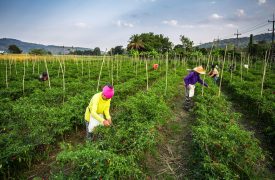See 2021 Food and Agriculture Benchmark
Nutrition | Leading practices from the 2021 Food and Agriculture Benchmark

What does good performance look like?
This is a question our food and agriculture team often receives from companies, allies and other stakeholders. Taking a holistic approach, companies in the benchmark are assessed across the measurement areas of governance and strategy, environment, nutrition and social inclusion. Companies are expected to set policies, strategies, targets or take specific action on each topic within these areas, all of which have specific (data) requirements. These requirements are based on societal expectations, existing and widely accepted reporting standards, best available science and guidance from experts, including research on existing initiatives and current practices. Translated into indicator scoring guidelines our methodology lays bare these requirements and why companies need to take action on each topic.
Food systems have major impacts on our health, society and the environment. Private sector action is crucially needed to address these challenges. The methodology for the Food and Agriculture Benchmark serves as a roadmap to guide companies through this transformation by identifying the areas of attention alongside clear expectations for companies. The 2021 Food and Agriculture Benchmark has shown that all companies are on a journey and stepping up efforts is needed even for the best performers. This publication aims to shine a light on leading practices on key topics that we have found in the benchmark. It provides a more practical understanding of what ‘good’ performance looks like, across topics as well as sectors and companies.
Below you find an overview of selected examples, chosen to illustrate leading practices across each measurement area and topic. These examples are intended to inspire and initiate conversations with companies on their performance. It is not an exhaustive list, but one that will be updated and supplemented moving forward. In addition, the benchmark’s data set provides a full overview of company scores against all 45 indicators, beyond the leading practice examples highlighted below.
Nutrition
The nutrition measurement are focusses on key topics to ensure healthy, safe and nutritious food for all. With one person in ten being hungry or undernourished, while simultaneously one in three adults being overweight or obese, global food systems need to see a real shift towards nutritious food. The topics in the nutrition measurement area include key changes needed to achieve healthy and sustainable diets. Industries in the food and agriculture system impact this shift in different ways and forms – but all keystone companies within the system have a role to play.
Accessibility and affordability of healthy foods
In 2020, one in three people in the world lacked access to adequate healthy and nutritious foods. Moreover, the high cost of healthy diets coupled with income inequality has made healthy diets unaffordable for around three billion people in the world. The COVID-19 pandemic has exposed the significant risk of food insecurity for vulnerable groups.
Responsible marketing and promotion of healthy food options
Responsible marketing communications are crucial to assist consumers in making appropriate choices and understand the role of heathy diets and lifestyles. Businesses play an important role in conveying marketing communication consistent with principles of good nutrition and diets, and, particularly, in reducing advertisement of nutritiously poor food options directed to children.
Workforce nutrition
In our world today, one in three people is malnourished, making malnutrition a global concern impacting individuals, households, businesses and economies. The 350 most influential companies included in the 2021 Food and Agriculture Benchmark collectively employ approximately 23 million people across the world. This number becomes significantly higher when adding the workforce in their global supply chains. As most people spend one-third of their time at work, business leaders have an opportunity to use the workplace to improve the nutritional status and wellbeing of millions of people.
Conclusion and next steps
Leading practice examples are meant to inspire and instigate conversations with companies on their performance. With changing global contexts and (scientific) developments and progress around the understanding of many of the relevant topics in the benchmark, leading practices will change over time. The benchmark and its methodology will reflect this changing environment in which food and agriculture companies operate. Our methodology will evolve over time, as will the benchmark. We invite our allies, companies and other stakeholders to join the conversation or reach out to the food and agriculture team to keep abreast of our activities and next steps.


